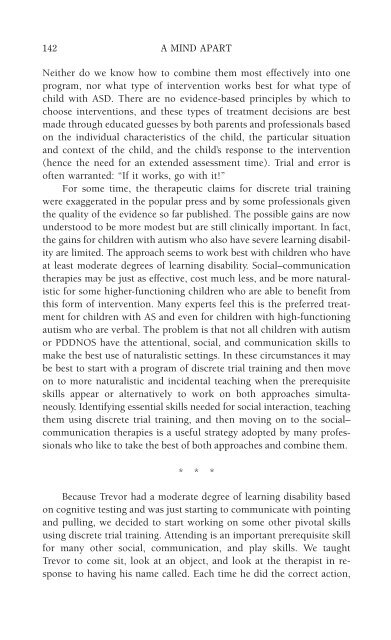978-1572305441
autism
autism
Create successful ePaper yourself
Turn your PDF publications into a flip-book with our unique Google optimized e-Paper software.
142 A MIND APART<br />
Neither do we know how to combine them most effectively into one<br />
program, nor what type of intervention works best for what type of<br />
child with ASD. There are no evidence-based principles by which to<br />
choose interventions, and these types of treatment decisions are best<br />
made through educated guesses by both parents and professionals based<br />
on the individual characteristics of the child, the particular situation<br />
and context of the child, and the child’s response to the intervention<br />
(hence the need for an extended assessment time). Trial and error is<br />
often warranted: “If it works, go with it!”<br />
For some time, the therapeutic claims for discrete trial training<br />
were exaggerated in the popular press and by some professionals given<br />
the quality of the evidence so far published. The possible gains are now<br />
understood to be more modest but are still clinically important. In fact,<br />
the gains for children with autism who also have severe learning disability<br />
are limited. The approach seems to work best with children who have<br />
at least moderate degrees of learning disability. Social–communication<br />
therapies may be just as effective, cost much less, and be more naturalistic<br />
for some higher-functioning children who are able to benefit from<br />
this form of intervention. Many experts feel this is the preferred treatment<br />
for children with AS and even for children with high-functioning<br />
autism who are verbal. The problem is that not all children with autism<br />
or PDDNOS have the attentional, social, and communication skills to<br />
make the best use of naturalistic settings. In these circumstances it may<br />
be best to start with a program of discrete trial training and then move<br />
on to more naturalistic and incidental teaching when the prerequisite<br />
skills appear or alternatively to work on both approaches simultaneously.<br />
Identifying essential skills needed for social interaction, teaching<br />
them using discrete trial training, and then moving on to the social–<br />
communication therapies is a useful strategy adopted by many professionals<br />
who like to take the best of both approaches and combine them.<br />
* * *<br />
Because Trevor had a moderate degree of learning disability based<br />
on cognitive testing and was just starting to communicate with pointing<br />
and pulling, we decided to start working on some other pivotal skills<br />
using discrete trial training. Attending is an important prerequisite skill<br />
for many other social, communication, and play skills. We taught<br />
Trevor to come sit, look at an object, and look at the therapist in response<br />
to having his name called. Each time he did the correct action,



